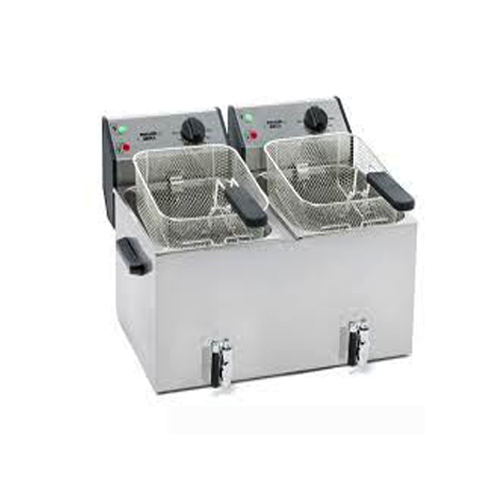In any commercial kitchen, efficiency, quality, and consistency are paramount. Among the many tools that chefs rely on, the professional fryer stands out as a critical piece of equipment. It not only enables the preparation of a wide range of fried foods but also directly impacts cooking times, energy consumption, and overall operational workflow. Choosing the right fryer requires careful consideration of factors such as capacity, energy type, safety features, and maintenance requirements.
Understanding the Types of Professional Fryers
The first step in selecting the right fryer is understanding the types available. Professional fryers generally fall into three main categories:
1. Countertop Fryers
These are compact fryers ideal for small kitchens or establishments with limited space. They are best suited for moderate cooking volumes and are relatively easy to maintain. Countertop fryers are energy-efficient and can handle daily frying tasks without consuming excessive power.
2. Floor Fryers
Larger and more robust, floor fryers are designed for high-volume operations. They typically feature larger oil capacities, advanced temperature controls, and heavy-duty construction. Floor fryers are suitable for busy restaurants, fast food chains, and catering kitchens where frying demands are continuous and high.
3. Pressure Fryers
Pressure fryers are specialized equipment that cooks food under pressure, reducing cooking time while retaining moisture and enhancing flavor. They are often used for fried chicken and other items where texture and taste are critical. However, they require more careful handling and routine maintenance to ensure safety.
Key Factors to Consider
Selecting the right fryer involves evaluating multiple factors to ensure it aligns with your kitchen’s needs and operational goals.
1. Capacity and Volume
Assessing the volume of food you plan to fry is essential. A fryer with insufficient capacity can slow down operations, while an oversized fryer may lead to energy wastage. Consider peak hours and average daily output to determine the appropriate oil capacity and basket size.
2. Energy Source
Professional fryers typically operate on either electricity or gas. Gas fryers heat up quickly and offer precise temperature control, making them ideal for busy kitchens. Electric fryers, on the other hand, provide consistent heat distribution and are easier to install in spaces without gas lines. Your choice should reflect both kitchen infrastructure and operational preferences.
3. Temperature Control
Accurate temperature control is crucial for achieving consistent results. Look for fryers with adjustable thermostats and digital controls. Advanced models may include automatic temperature regulation, which helps maintain optimal frying conditions even during prolonged cooking periods.
4. Safety Features
Safety should never be compromised in a commercial kitchen. Professional fryers should include features such as automatic shut-off systems, cool-touch handles, and oil filtration mechanisms to prevent accidents. Proper ventilation and adherence to fire safety standards are also critical considerations.
5. Oil Management and Filtration
Oil quality directly affects the taste and appearance of fried food. Fryers with built-in filtration systems or easy-to-drain oil containers simplify maintenance and extend oil life. Some models offer automated oil filtration, reducing labor and ensuring consistent food quality.
6. Durability and Construction
Investing in a professional fryer is a long-term decision. Stainless steel construction, reinforced baskets, and durable heating elements enhance the fryer’s longevity. Additionally, fryers with removable components are easier to clean and maintain, minimizing downtime.
7. Space and Layout Considerations
Ensure the fryer fits seamlessly into your kitchen layout without obstructing workflow. Floor fryers require dedicated space with proper ventilation, while countertop models can be placed on work surfaces for quick access. Efficient kitchen design contributes significantly to operational efficiency.
Maintenance and Operational Tips
A well-maintained fryer improves food quality, reduces costs, and extends equipment life. Some essential maintenance practices include:
-
Regular Cleaning: Daily cleaning of baskets, oil containers, and exterior surfaces prevents buildup of residue and ensures hygiene.
-
Oil Management: Regularly filter oil and replace it when necessary to maintain flavor and prevent health risks.
Routine Inspection: Check heating elements, thermostats, and safety features to detect issues early. -
Staff Training: Ensure kitchen staff are trained in safe fryer operation, oil handling, and emergency procedures.
Enhancing Kitchen Efficiency
Choosing the right professional fryer goes beyond just selecting the correct model. Integrating fryers into a well-organized kitchen workflow can drastically improve efficiency. Consider pairing fryers with other complementary equipment such as warming stations, prep tables, and storage units to streamline operations. Proper workflow planning reduces bottlenecks during peak hours and maximizes the fryer’s performance.
Energy Efficiency and Sustainability
Modern professional fryers increasingly focus on energy efficiency. Look for models with rapid heating technology, insulated tanks, and programmable cooking cycles. These features reduce energy consumption, lower operating costs, and minimize environmental impact. In addition, adopting sustainable practices like responsible oil disposal and using reusable filtration systems contributes to an eco-friendly kitchen operation.
Final Thought: Investing in the Right Solution
Selecting the right professional fryer is a strategic decision that can elevate the quality and efficiency of your commercial kitchen. By considering factors such as capacity, energy source, safety features, and maintenance requirements, you ensure that your kitchen operates smoothly and safely. A well-chosen fryer not only improves food consistency but also optimizes labor and energy usage.
For restaurants and commercial kitchens looking to streamline operations, integrating a professional fryer as part of comprehensive turnkey restaurant solutions ensures long-term efficiency, reliability, and high-quality food service.



